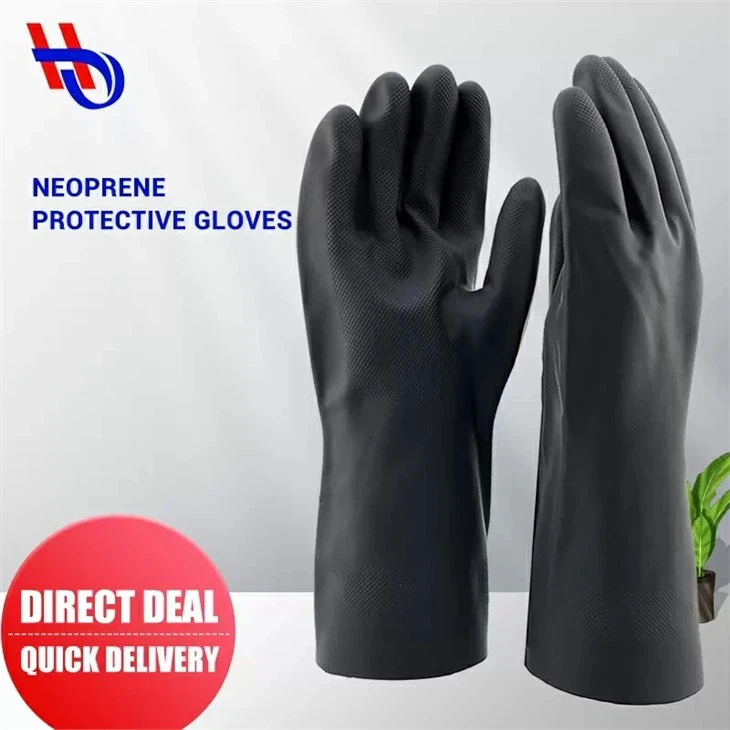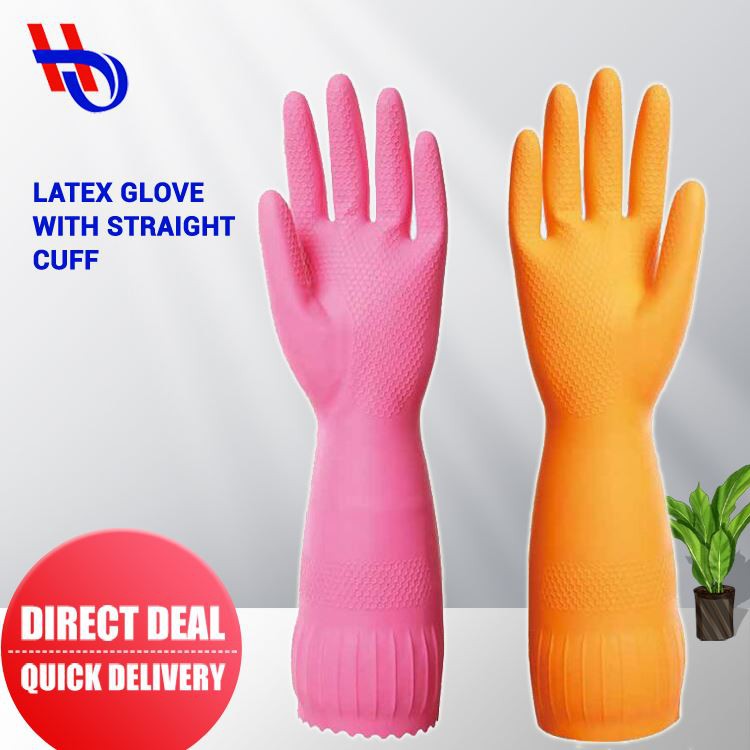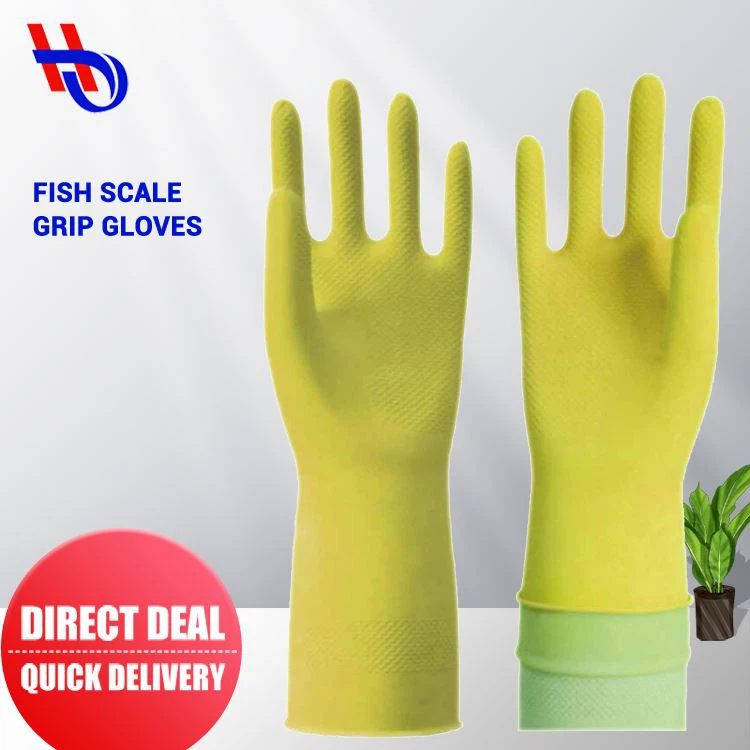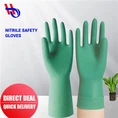Neoprene Gloves
What is Neoprene Gloves
Personal protection equipment (PPE) such as neoprene gloves is necessary for various tasks. They provide us with the essential protection and dexterity to do our work as quickly as possible. When made into gloves, neoprene is a synthetic rubber material that provides waterproof protection against a number of liquids and chemicals. Neoprene's exceptional waterproofing makes the material ideal for diving gloves, wetsuits, culinary gloves, and other similar applications. The polymerization method, which involves many chemical reactions, is used to make neoprene gloves. The pair has exceptional pliability and protecting qualities as a result of this essential manufacturing procedure.
Advantages of Neoprene Gloves
Comfortable fit
Neoprene synthetic rubber comfortably hugs your hands and fingers without restricting your movement and discomfort. Due to their material, neoprene work gloves are stretchable and will return to their original size and form after stretching.
Waterproof
Neoprene rubber is moisture and liquid resistant without affecting your grip or getting your hands wet. If your tasks require handling liquids or doing water sports, but you need gloves, neoprene waterproof gloves are the best choice for you.
Flexible
Neoprene is a brilliant material that allows freedom of hand and finger movement and doesn’t dull or hinders finger sensitivity. As a result, neoprene work gloves are preferred by doctors and surgeons.
Thermal insulation
Neoprene gloves will keep your hands warm even in cold temperatures or playing water sports. The best part is that even though neoprene gloves are exposed to high or low temperatures, they will not turn brittle, split, or deteriorate.
Abrasion resistance
Although not as sturdy and durable as kevlar or stainless steel gloves, neoprene gloves provide abrasion, puncture, and cut resistance. Wear neoprene gloves when you handle sharp objects, equipment, and materials to protect your hands and yourself.
Why Choose US
Our factory
Beijing Huateng Rubber and Plastic Latex Products Co., Ltd. was established in 1958. The company has excellent performance in China's latex impregnation products. The registered capital of the Company is 120 million yuan, and the value of fixed assets is 258 million yuan. The annual turnover exceeds 800 million yuan.
Our Product
We mainly develop nitrile protective gloves and neoprene protective gloves. At the same time, our company provides different kinds of work gloves, protective gloves and waterproof boots to the domestic and foreign markets.
Our certificate
The company has passed ISO9001: 2015 quality management system and ISO14001 environmental management system certification. Latex gloves have passed EU CE certification
Production equipment
It has strong scientific research and development ability and technical testing means, and the factory has complete industrial sanitation, labor protection and fire protection facilities that meet the environmental protection standards.
Powerful industrial production utilities
Power supply capacity is 4250KVA, and water supply capacity is 240t/h circulating water capacity. 300t/h, heating capacity 32t/h, the water supply and drainage facilities in the plant area are complete and connected with the municipal pipe network.

Neoprene gloves are manufactured from a synthetic material rubber called chloroprene. They are made through a free radical polymerization process involving different chemical reactions that turn the polymers into a more flexible material.
Neoprene gloves protect wearers from harmful environmental factors such as oils, flames, heat, and abrasion. They also protect against hydraulic fluids, alcohols, gasoline, akalis, and organic acids.
Neoprene resists degradation better than natural rubber, so these types of work gloves will last longer. The neoprene glove is used in a wide range of applications, including industrial chemical processing, printing industries, oil refineries, automotive paint shop, pesticides handling, agriculture and environmental clean-up.
How Rubber Gloves Are Made
Step 1: Cleaning of ceramic former
Since everything has to form on the ceramic former, it must be clean! I.E free from powder, dust and contamination. It is achieved by passing formers through the acid tank which dissolve glove release powdering agent used in the processes.
After the acid treatment, the formers are passed through subsequent hot water rinsing which effectively strips the former of any remaining residual chemicals thereby effectively cleaning the formers.
Step 2: Calcium salt treatment.
The formers are then passed through specially formulated liquid called the coagulant which effectively helps in uniform and smooth coagulation of compounded latex onto the former. Also the liquid comprises glove release agents that aid in stripping the finished gloves off the former for subsequent packing.
Step 3: Dip into latex.
After the coagulant solution on the former has dried in the ovens, it is dipped into compounded latex. The compounded latex coagulates on the former forming a semi solid gel. This gel is the birth of your glove.
Step 4: Leaching
The gel is dried in the ovens and leached in hot water. All water soluble ingredients in the gel like allergy causing proteins, residual salts and soaps are removed. Leaching also helps in effective curing of gloves and increases its shelf life!
Step 5: Curing
For the gel to become a fully formed glove, it needs to be cured in long hot ovens for 20 minutes. This causes the rubber to form crosslinks in the presence of accelerating chemicals, sulfur thereby rendering it strong and elastic.
Step 6: Post leaching and corn starch powdering.
The cured glove is leached one more time to effectively remove any residues on the film and it is rendered for final powdering by corn starch. Cornstarch is a lightweight and natural moisture-absorbing powder which possesses antibacterial properties and soothes skin, unlike other chemically formulated powders which can irritate your skin.
Step 7: Stripping
After this process the gloves are stripped off the formers by air blowing or automated glove removal. The gloves are collected by personnel and sent for offline tumbling.
Step 8: Tumbling
The gloves are tumbled in big hot wash dryers to remove excess powder. The heat further cures the glove and renders it fit for use.
Step 9: Packing
The gloves are counted by weight and packed into boxes to be dispatched to you!
Best Uses for Neoprene Gloves
Research and innovation within the medical field continues to allow new and diverse products to be developed that aid staff and patients in preventing the spread of contaminants. Neoprene gloves are one such invention, often used as an alternative to traditional latex for both surgical and examination applications. These gloves really do have it all. They are lightweight, offer a high protection level and are very durable in all types of uses.
One of the greatest risks to medical staff is contact with contaminated materials such as blood, body fluids and very high risk viruses. Neoprene gloves are a perfect option for any type of patient care where these issues are present. This applies for both medical facilities as well as those professionals providing home health care services. In addition, any type of procedures that involve a lot of hand movement, fine detail work or procedures using surgical instruments are a great match for the neoprene gloves. This is because they are fitted to the hand and extremely durable and puncture resistant.
Unlike latex gloves, neoprene gloves don’t have any rubber protein and has an extremely low chance of causing any type of allergic reaction either by staff or patients. It is also a good exterior protection that limits any possible leakage or seepage of fluids into the glove during use. Like nitrile gloves, neoprene gloves tend to tear or rip if punctured, allowing the wearer to immediately take action to avoid any further contamination. However, these gloves are extremely resistant to damage and puncture, and are typically rated with a tensile strength of more than 3000 pounds per square inch when intact and undamaged.
Like a film, neoprene follows the natural contour of the hand similar to latex gloves. It is highly elastic, especially when stretched down the length of the glove. This means that it is easy to pull on and remain sterile while not stretching out of shape as the hand is moved during any type of use. Since the elasticity of the neoprene glove is slightly more than latex there is an initial adjustment for most users. Typically people simply switch to a larger size in this type of material if they feel that the elasticity is too constricting or uncomfortable.
Neoprene gloves have a higher level of chemical resistance that vinyl or latex gloves. This means that it is safe to use with most water and oil based liquids and materials. It is also resistant to chemicals, making it a good match for surgical work as well as laboratory tasks. These gloves are the new wave in examination and sterile surgical gloves and represent the best of all types of gloves.
Using neoprene gloves is a great way to ensure you have the thin, flexible protection you need with the durability of a much thicker, heavier glove. They are slightly more expensive than latex, but with all the benefits they offer, this price difference is often not significant. Neoprene gloves can be marketed for both surgical or sterile procedures as well as for examination gloves, making them a great addition in any health care task.
Neoprene and nitrile have a lot in common- they are both stretchy synthetic rubbers, durable, and great glove materials. However, they also have different characteristics, like their resistance to heat, flame, abrasion, and other substances, that make them suitable for specific applications.
Nitrile gloves are made & what they can be used for
The name Nitrile was coined from Acrylonitrile- Butadiene rubber. This is because Nitrile is made from two volatile synthetic liquids; Butadiene and acrylonitrile.
Acrylonitrile is a man-made colorless liquid chemical with a strong smell, similar to onion or garlic. It is responsible for the nitrile gloves' resistance to harsh substances. Butadiene, on the other end, is a colorless gas and organic compound. It gives nitrile gloves their flexibility and conformity. It allows the glove users to feel tactile sensitivity even with their clad hands.
Glove manufacturers combine butadiene and acrylonitrile, which causes a chemical reaction called polymerization, resulting in the production of liquid nitrile. They then filter the liquid nitrile and add coagulating agents and antioxidants to structure the material.
In its liquid state, the gloves manufacturers dip coated human hand molds into the nitrile. They then bake it and leave it to cool off and dry, after which they are coated in polymer for easy wearing and removal.
Nitrile gloves have the following properties;
High Chemical resistance
High water resistance
High Abrasion resistance
Oil and gasoline Resistance
Puncture resistance
These properties make nitrile gloves useful in many industries, from food to engineering. Some of the things you can use nitrile gloves for include;
Hazardous substance handling: Because nitrile glove chemical resistance is superior, they are ideal for handling corrosive acids and other organic solvents.
Food handling: Nitrile gloves are food safe and can be used in food preparation because of their resistance to odor and stains. You can use them to handle oily food without contaminating or weakening the gloves.
Medical use: Nitrile gloves protect users from contamination and prevent them from spreading contaminants. It is highly favored in the medical industry because of its puncture resistance and ability to withstand harsh conditions.
Latex gloves alternative: Since nitrile gloves are latex-free, they have a low tendency to trigger allergies. They are an ideal replacement for anyone who has sensitive skin or allergies.
Neoprene gloves are made & what they can be used for
Neoprene is produced from a lab-synthesized rubber called chloroprene ( carbon, hydrogen, and chlorine polymer.) At the start of the process, the chloroprene is polymerized to bind all the molecules together and form polychloroprene chips.
Neoprene glove manufacturers melt the polychloroprene chips and add carbon pigments and foaming agents to form the liquid material. After, they dip human hand molds into it, bake it, and coat it with polymer when it is dry to make it easy to put on and off.
The gloves are then tested before shipping to wholesalers.
Because of its component and polymerization processing, Neoprene gloves have the following attributes;
Sunlight, weather, and ozone resistance
Exceptional impact resistance and textile strength
Elastomeric
Flame resistance
Water resistance
Handling wet objects: Neoprene is an ideal choice for handling liquid because of its waterproof ability. Its material allows you to maintain a grip on objects when working with liquid. Dentists and other medical personnel can benefit significantly from neoprene gloves since they handle wet instruments a lot.
Handling common chemical substances: Neoprene gloves don't deteriorate when handling common caustic chemicals and petroleum-based mixtures. That makes them handy for lab workers, physicians, and other industry workers that deal with harmful substances.
Printing: Neoprene gloves offer exceptional hand protection that prevents risks involved in printing tasks. They are ideal for frame cleaning and scrubbing during printing and can last long when used appropriately.
Environmental clean up: Neoprene gloves are suitable for outdoor activities because of their resistance to environmental factors, like sunlight oxidation, UV rays, ozone, and other weather conditions.
How to Clean and Store Rubber Gloves




How to clean reusable gloves
Gloves are worn for protection, so cleaning them can extend their lifespan and protect against contamination. Here is a step-by-step process to help you clean your gloves whether they are vinyl, nitrile, or latex gloves:
Washing the outside of the gloves with soap or a mild detergent and hot water while they are still on your hands can help keep them sanitary. Rub the gloves together or with a cloth to remove dirt, germs, and other organic materials. Thoroughly rinse the gloves under running water.
Take off the gloves and wash your hands with soap and water.
Soak the gloves inside out in a mixture of soap and water for a few minutes.
Hang the gloves to dry in a well-ventilated location. Make sure they are completely dry before folding them and putting them away.
Keep the clean rubber gloves in a dry place to prevent mildew growth.
When not to wash
To protect workers from infections, each individual should have his/her own pair of disposable gloves. So, wash only your personal disposable gloves.
Gloves should be discarded after wearing for any length of time in contact with blood and bodily fluids, or extremely soiled items.
Dispose of a rubber glove when it becomes discolored, cracked, or visibly punctured, or ripped.
How to disinfect rubber gloves
Disinfectants are agents that destroy microorganisms on inanimate objects. They work by destroying the nucleic acids and proteins that make up all microorganisms, but should only be used on objects, never on the skin.
After washing your gloves, be it latex gloves or what, make sure to dry them completely before proceeding to sanitation or disinfection.
Clean the outside of rubber gloves with a sanitizing or disinfecting product to kill any germs left behind by your hands. Before using such products, read the label carefully to ensure that it is safe for use on the material of your gloves and follow all directions.
Be sure to wash your hands thoroughly after.
Important reminder on disinfecting gloves:
The environmental protection agency has a list of registered disinfectants, but you should know that "epa-registered surface disinfectants, including surface wipes, should not be applied on your skin or ingested." for safety reasons, do not wipe down the inside of the gloves with the disinfectant as it may cause skin irritations.
How to sanitize rubber gloves
Sanitizers are agents used to rapidly reduce the number of disease-causing bacteria on inanimate objects in a short period of time. The process of sanitizing is basically the same as cleaning, and can be used to clean dishes, hard surfaces, and skin.
To sanitize your gloves, you can use the same process laid out above on washing your glove with mild detergent or sterilize them with an ethanol solution using the process below.
Sanitizers vs disinfectants
Sanitizers are used at concentrations that kill microorganisms but don't leave behind residue that can harm food or cause skin irritation; disinfectants are used at much higher concentrations to kill microorganisms, but may also leave harmful residues on food and skin.
How to sterilize latex gloves
Sterile latex gloves are often used in healthcare services to prevent the dangerous transmission of microorganisms upon contact. However, gloves can be sterilized at home for tasks in which the risk of infection is not great.
Prepare your 70% ethanol solution or make one if you don't have one. If you have already purchased a 70 percent ethanol solution for this task, skip this step.
If you do not have an ethanol solution available, prepare it by mixing 100% ethanol with distilled water in a ratio of 7:3. Pour the 70% solution into a clean spray bottle using a funnel to avoid spilling.
Before you begin to sterilize latex gloves, wash your hands thoroughly with soap and water. Make sure you wash your fingers and wrist well, and avoid touching any surface other than the gloves.
Spray the outside of the glove thoroughly, then use your fingers to turn it inside out. Repeat this procedure until all areas of both gloves have been covered with ethanol.
After you sanitize the latex gloves, you can put them on to begin your task. But be careful not to touch any surface or ground before doing the task.
How to store reusable gloves
Keep the washed gloves in a clean, dry area that has been disinfected to reduce the risk of contamination.
Gloves should be stored in a well-ventilated area, away from direct sunlight.
Check gloves before wearing them. Punctures, discoloration, or tears indicate a potential problem.
FAQ
We're well-known as one of the leading neoprene gloves manufacturers and suppliers in China. Please feel free to wholesale high quality neoprene gloves at competitive price from our factory. For OEM service, contact us now.
Neoprene Protective Gloves, Neoprene Gloves, Bicolor Neoprene protective Gloves





